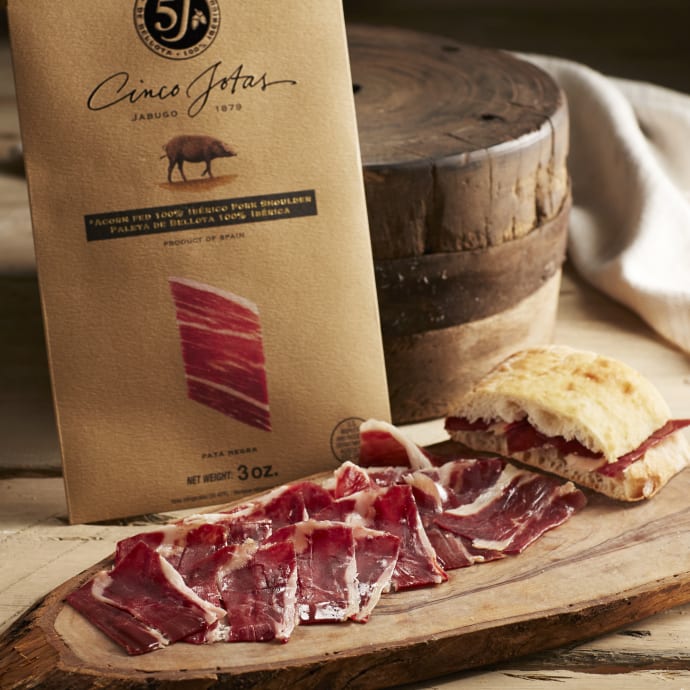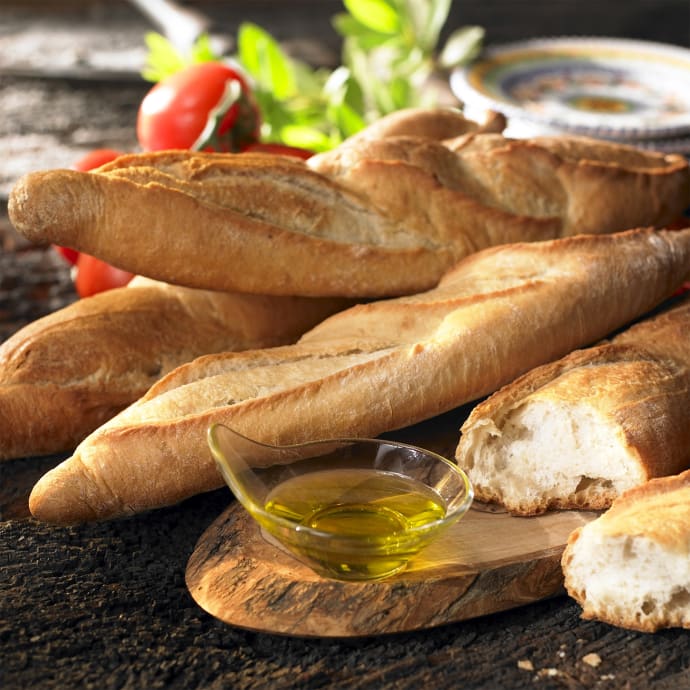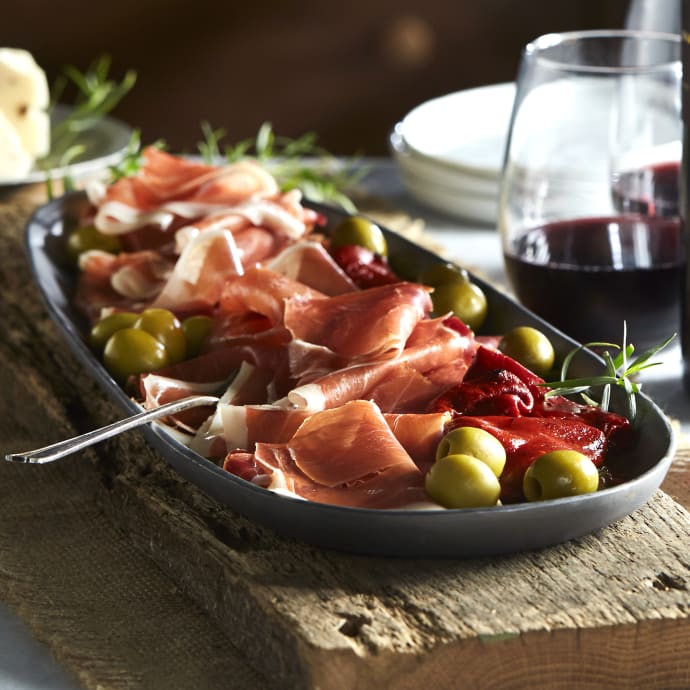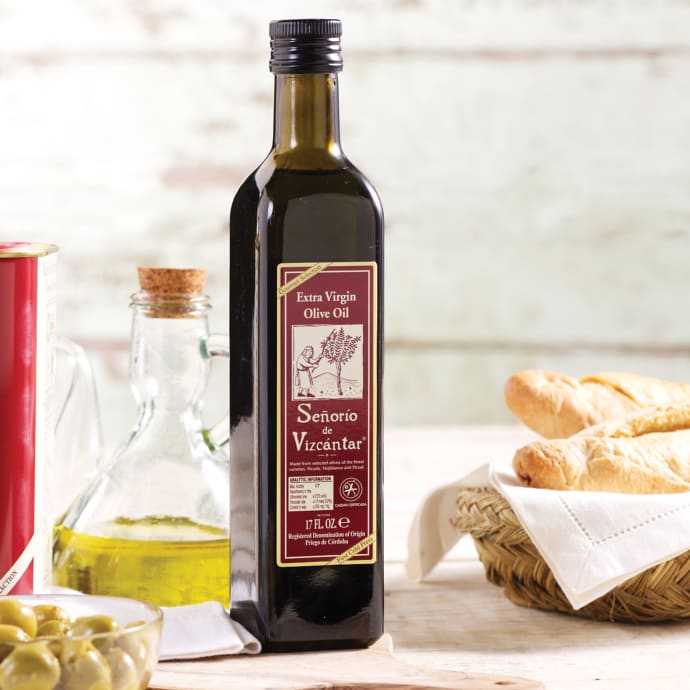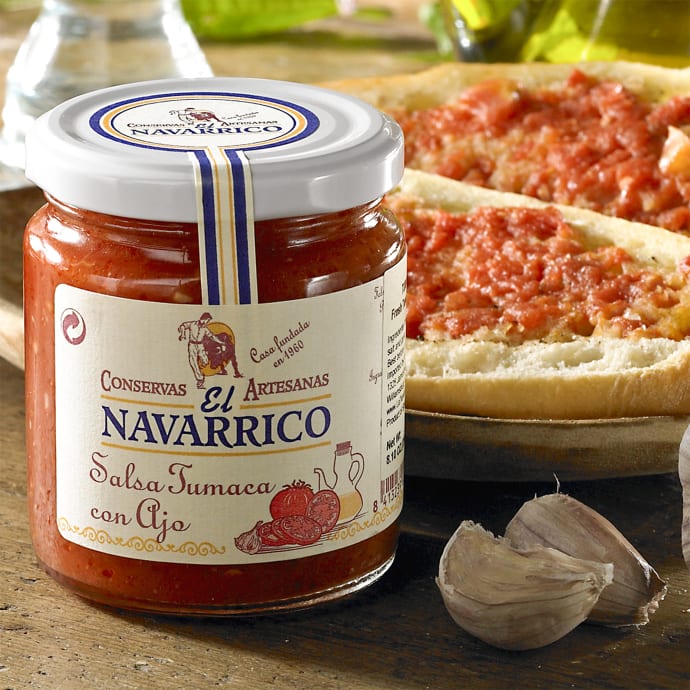Three Kings Sale - Up to 40% Off! Shop Sale

Dish: You'll go nutty for Spanish 'jamon'
Pittsburgh Post-Gazette
-
February 14, 2008
Iberico pigs enjoy a free-range diet of acorns under holm oak trees near the town of Badajoz in the Spainish region called Extremadura.
Iberico ham is the pride of Spain. Like Beluga caviar or Kobe beef, Jamon Iberico is the ultimate ham. Many believe it to be the very best in the world.
Until recently, Iberico had been unavailable in the United States due to issues with processing that have been addressed; it now conforms to federal regulations. Finally, in December, the first Jamones Ibericos arrived. In celebration of its debut, the first ham was sliced by Spanish and American celebrity chef Jose Andres at Jaleo in Washington, D.C. The Spanish ambassador to the United States cadged one of the first slices.
Ah, but the best is yet to come. The crown jewel, top-of-the-line, best-of-the-best Spanish ham is Jamon Iberico de Bellota. These rare hams come from animals who spend their days feasting on the oil-rich acorns (bellotas) from oak trees, which infuse their meat with flavor. This acorn-fed ham will be arriving in America in late summer.
With apologies to my Italian friends, a side-by-side comparison with Jamon Iberico de Bellota makes Italian prosciutto taste like chipped ham.
Tasting is believing
I had the enormous good fortune to savor this ham eight years ago on my birthday. My husband, Bob Wolke, and I were traveling in Extremadura in western Spain with food journalist friends. It was a bright, sunny November day in "the land of the pig," and we were invited for a mid-afternoon meal on the estate of a family who raised the prized hogs.
When our van got stuck in a muddy rut, we walked the rest of the way to the manor house through the fields under the trees. The free-ranging pigs were all around us, and while they were somewhat curious, they mostly ignored us and kept nuzzling acorns on the ground.
I swear they seemed content and happy. Why not? They were living in a porky paradise, eating all they could hold, their every need cared for.
The lunch served that day on the patio was so locally produced I could see the sources. The table was set with bowls of black and green olives and flasks of recently pressed and unfiltered olive oil, both from the olive grove nearby. There were platters of cheeses, and yes, I could see the cows. Egg-and-potato Spanish tortillas were bright yellow from the yolks of the chickens pecking for grubs off to the side of the kitchen. There were platters of pork charcuterie, cazuelas of pork stew and baskets of rustic bread. Dessert, a nut tart, was made from the delicious acorns that the pigs feast upon. What a brilliant touch of continuity, I thought.
But all eyes were on the ritual slicing of the Jamon Iberico de Bellota. The whole, black-footed leg was clamped horizontally to a special stand. A man holding what looked like a short conductor's baton stood beside it. Before beginning, he inserted the baton, a thin horse bone, into the meat, removed it, and sniffed. He gave a short nod to indicate he liked what he smelled. He then used a long, thin slicing knife to cut away a layer of fat, which would be reserved to cover the cut surface to keep it from drying out. He rhythmically removed paper-thin slices about 3 inches long, overlapping them slightly on a serving plate. Each slice, streaky with marbled fat and rosy-to-winey-to-mahogany in color, had a wide edge of glistening fat.
As we held a slice in our palms, the fat began to melt. We then tasted the first pieces by warming them on the tongue to release the nutty aroma. The taste was incredibly delicious, intense and concentrated, not salty or sweet, but more like umami. We alternated tastes of Iberico with bread dipped into the olive oil and sips of local red wine. The trio of flavors resonated on the palate. It was unforgettable bliss.
That melt-in-the-mouth fat consists of 55 percent oleic acid, the heart-healthy monounsaturated fat found in olive oil. These pigs' fat is much more like vegetable oil than animal fat.
"I've been told by growers like this one that the acorn-fattened Iberico pig is like an olive tree on four legs," said our friend Janet Mendel. Ms. Mendel, an American writer who has lived in Spain for many years, is the author of six books on Spanish cooking, including "Cooking From the Heart of Spain" (Morrow, 2006). "About 90 percent of what makes this a superior ham has already been accomplished before the pig is even slaughtered. This is the real deal. It never gets better than Bellota."
Back story
The lineage of the black-hoofed (pata negra) descendants of native boar that produce these hams goes back to pre-history, when they ran wild in the Iberian Peninsula. Later on, Christopher Columbus, a fellow with an eye for fine provisions, had some of these pigs on the Santa Maria when he set out to discover the New World.
There are two types of these pigs; one lives the life of a normal domestic pig, and one is free-range fed on acorns and wild plants. The only difference is in diet and exercise, but those things make all the difference in the world.
From birth, the hogs destined for Bellota quality are treated royally. They live, sleep and forage in the open in specially maintained oak forests, called "la dehesa," which is a unique ecosystem of meadow, grass and scrub dotted with holm and cork trees. The pigs typically have more than five acres in which to forage and roam, and they live for about two years in this setting -- longer than the life span of a normal domestic pig.
When they bulk up in the fall, the pigs put away 15 to 20 pounds of acorns a day, allowing them to gain as much as 2 pounds daily. The Spanish have a reverent term for their eventual slaughter -- the hams are "sacrificed."
After a vet inspects the carcasses, they are cleaned and chilled. Butchers then carve the legs for hams.
Processing the hams takes time, however. They are trimmed and sculpted by removing the skin but leaving about an inch of fat. Then they are salted and left for a week after which they are washed and sent to hang in a drying room for a few months. Finally, they are hung to age from two to four years, when, like fine wine and cheese, the hams mature and develop flavor.
Spaniards consume the vast majority of these rare Bellota Iberico hams. Some producers have waiting lists for several years for their best products, because they can't produce enough hams to meet the demand. Besides Spain, France and Japan are the big customers. The United States just joined that list.
Three little pigs
How do you know you are getting the real deal? Read the label, pay the price.
• Iberico Bellota. The best-quality Iberico carries this label. Within Spain, this ham has four geographical Denominations of Origen, all in southwestern Spain. There is a consortium named Real Iberico whose producers label their product with a certificate of guarantee. These are the hams that should be available in the United States in late summer. Should, I say, because shipping and importing variables may prevail.
• Iberico. This ham is produced from the Iberico breed, but fattened on pig feed and grain. While Jamon Iberico is the formal name, pata negra or "black hoofed" is the informal term or nickname because many Iberico pigs have a black foot.
• Serrano. A third kind of Spanish ham is made from ordinary pigs, country cousins of the Iberico. Serrano ham is made anywhere in Spain from cross-breed pigs. This is the ham that is found in every tapas bar and restaurant.
But beware. When purchased, all three types must be held at ideal conditions and be freshly sliced, thinner than thin.
Where to buy
In Spain: The biggest department store chain in Spain is El Corte Ingles. On the lower level of the larger stores is a supermarket. It's a must-stop for tourists who want to bring home Spanish ingredients such as smoked pimenton (paprika) or canned fish. Hanging from the ceilings in the butcher area are rows and rows of whole hams. Small cones attached to the bottoms catch drips of fat. All of the whole bone-in Iberico hams have hooves, or patas, attached, to prove that they are true Ibericos. Buy a few slices along with a loaf of bread and bottle of wine and some olives and have a mini-picnic, even if it's in a hotel room.
In the States: Iberico ham is now available in high-end food stores in New York, Washington, Chicago and other large cities, but not in Pittsburgh. It costs upwards of $50 a pound, or about $800 for a whole, bone-in ham. When Iberico de Bellota is available in late summer, the price probably will be about double the Iberico.
You aren't going to plop this pricey baby on the counter and hack away with a Swiss army knife. You need to have accessories -- a thin, stainless steel carving knife and a ham holder. At La Tienda, an importer of Spanish goods, a hardwood ham holder with swivel grip is available for $950 plus shipping. They also have the Salamanca model at $595, and the cheapest all-purpose ham-holder at $69. But then what would your friends say?
Shop for hundreds of Spanish items including all the hams mentioned here at www.latienda.com.
Catalan Toasts Pan Catalan
In Catalonia, this is called "bread with tomato." Elsewhere in Spain, it is called "Catalan Toast." It is served as a tapa, but makes a wonderful breakfast treat. An icon of the foods of Spain, this is best when tomatoes are at the height of the season.
* 1 ripe tomato
* 6 diagonally sliced pieces of baguette about an inch thick
* 1 clove garlic
* 2 tablespoons extra virgin olive oil
* 6 thin slices serrano ham, about 2 ounces
Cut the tomato in half crosswise and grate it coarsely, discarding the skin. Arrange the bread slices on a broiler pan and toast both sides. Rub each toast with the cut side of a clove of garlic. Spread the tomato pulp on top. Drizzle each with olive oil. Arrange the ham on top.
Makes 6 pieces. (If you love the toast, it will serve 2 or 3.)
-- "Cooking From the Heart of Spain" by Janet Mendel (Morrow, 2006)
Marlene Parrish can be reached at mparrish@post-gazette.com or 412-481-1620.
Other Press
The Winter Travel Shortlist: Problem-Solving Essentials I’m Packing This Season
Forbes
-
November 20, 2025
54 Gifts for People Who Have Everything
Wirecutter
-
November 6, 2025
What Andrew Zimmern Can’t Live Without
The Strategist
-
June 30, 2025
8 Tasty Ways To Travel The World With Food
Forbes
-
June 17, 2025
Featured Products
 SHIPS FREE
SHIPS FREECinco Jotas Boneless 100% Ibérico de Bellota Jamón - FREE SHIPPING!
JM-107
(2)
$1,599.00$1,599.00
 SHIPS FREE
SHIPS FREECinco Jotas Bone-In 100% Ibérico de Bellota Jamón - FREE SHIPPING!
JM-106
(4)
$1,599.00$1,599.00
 BEST SELLER
BEST SELLERCinco Jotas Sliced 100% Ibérico de Bellota Shoulder - 3 oz
JM-111
(22)
$55.00$55.00
 BEST SELLER
BEST SELLERSliced Ibérico de Bellota Ham by Peregrino, Nitrate Free - 2 oz
JM-52
(47)
$42.00$42.00
 SALE
SALEGalician Bread - Barra Española
BD-37
(122)
4 for $32.00 $29.00
 BEST SELLER
BEST SELLERSliced Serrano Ham by Peregrino, Nitrate Free - 6 oz
JM-01
(96)
$19.00$19.00
 BEST SELLER
BEST SELLERSeñorío de Vizcántar Special Selection Extra Virgin Olive Oil
OO-45
(42)
$29.00$29.00

Salsa Tumaca - Traditional Fresh Tomato Spread
SC-33
(11)
2 for $9.00$9.00



